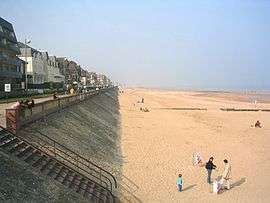Cabourg
| Cabourg | ||
|---|---|---|
 | ||
| ||
 Cabourg | ||
|
Location within Normandy region  Cabourg | ||
| Coordinates: 49°17′17″N 0°06′59″W / 49.2879810°N 0.1162920°WCoordinates: 49°17′17″N 0°06′59″W / 49.2879810°N 0.1162920°W | ||
| Country | France | |
| Region | Normandy | |
| Department | Calvados | |
| Arrondissement | Caen | |
| Canton | Cabourg | |
| Government | ||
| • Mayor (2008–2014) | Jean-Paul Henriet | |
| Area1 | 5.52 km2 (2.13 sq mi) | |
| Population (2013)2 | 3,709 | |
| • Density | 670/km2 (1,700/sq mi) | |
| Time zone | CET (UTC+1) | |
| • Summer (DST) | CEST (UTC+2) | |
| INSEE/Postal code | 14117 / 14390 | |
| Elevation |
0–15 m (0–49 ft) (avg. 5 m or 16 ft) | |
|
1 French Land Register data, which excludes lakes, ponds, glaciers > 1 km² (0.386 sq mi or 247 acres) and river estuaries. 2 Population without double counting: residents of multiple communes (e.g., students and military personnel) only counted once. | ||
Cabourg is a commune in the Calvados department in the Normandy region of France. Cabourg is on the coast of the English Channel, at the mouth of the river Dives. The back country is a plain, favourable to the culture of cereal. The town sits on the Côte Fleurie (Flowery Coast) and its population increases by over 40,000 during the summer.
History
It was from Cabourg that William the Conqueror drove the troops of Henry I of France back into the sea in 1058.
According to Marcel Proust's biographer George D. Painter:
But the modern Cabourg began in 1853 with the arrival of two Paris financiers in search of a new site for a luxurious watering-place. The railway age had made the Normandy coast accessible to holiday-makers; Dieppe, Trouville and Deauville to the east had already been discovered; but here the adventurers found a virgin expanse of barren dunes and level sea-sands ripe for development. By the 1880s an unreal city of villas and hotels had arisen, in a semicircle whose diameter was the seafront, whose centre was the Grand Hotel, and whose radii were traced by a fan-work of avenues shaded with limes and Normandy poplars.[1]
Population
| Historical population | ||
|---|---|---|
| Year | Pop. | ±% |
| 1962 | 3,022 | — |
| 1968 | 3,067 | +1.5% |
| 1975 | 3,308 | +7.9% |
| 1982 | 3,238 | −2.1% |
| 1990 | 3,355 | +3.6% |
| 1999 | 3,520 | +4.9% |
| 2008 | 4,026 | +14.4% |
Climate
Cabourg is under the influence of an oceanic climate, with fresh summers and very mild winters.
Culture
Each year in June, Cabourg hosts the International Festival of the Romantic Movie.
Personalities
Cabourg is famous for being Marcel Proust's favorite vacation place at the beginning of the 20th century; it is the inspiration for Balbec, the seaside resort in Proust's In Search of Lost Time.[2]
- Jean-Pierre Andréani
- Charles Bertrand (politician) (1884, Avesnes-sur-Helpe–1954)
- Sandrine Bonnaire
- Bruno Coquatrix (1910, Ronchin–1979)
- Jean-François Dubos
- Tristan Duval
- Adolphe d'Ennery (1811–1899)
- Jean-Louis Ezine (*1948, Cabourg)
- Philippe Fourastié
- Jacques Freimuller
- Gilgogué
- André Lenormand
- Corinne Lepage
- Charles-Gaston Levadé (1869–1948),
- Cecil Michaelis
- René-Xavier Prinet (1861, Vitry-le-François–1946)
- Pierre Ucciani (1851, Ajaccio–1939)
International relations
Cabourg has relations with the following cities:[3]
 Atlantic City, USA
Atlantic City, USA Bad Homburg, Germany
Bad Homburg, Germany Bromont, Canada
Bromont, Canada Chur, Switzerland
Chur, Switzerland Jūrmala, Latvia
Jūrmala, Latvia Mayrhofen, Austria
Mayrhofen, Austria Mondorf-les-Bains, Luxembourg
Mondorf-les-Bains, Luxembourg Oussouye, Senegal
Oussouye, Senegal Salcombe, United Kingdom
Salcombe, United Kingdom.svg.png) Spa, Belgium
Spa, Belgium Terracina, Italy
Terracina, Italy
Popular culture
- The Cabourg area, including the small hamlet of Varaville, is the setting for some of the events in the novel Villa Normandie by Kevin Doherty.
References
- ↑ George D. Painter, Proust: The Later Years (Little, Brown, 1965), p. 84
- ↑ Cabourg (Balbec)
- ↑ "Relations Internationales". cabourg.net. Retrieved 26 April 2014.
External links
| Wikimedia Commons has media related to Cabourg. |
- Official website (English) (French)
- Cabourg website (French)
.svg.png)